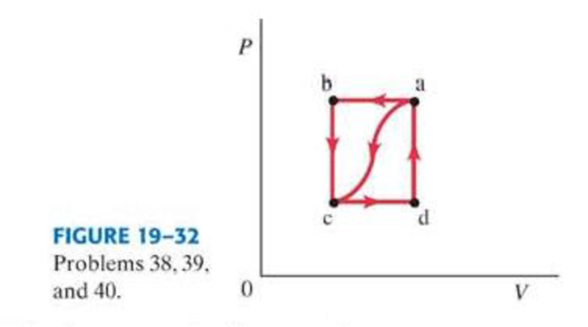
(III) In the process of taking a gas from state a to state c along the curved path shown in Fig. 19–32, 85 J of heat leaves the system and 55 J of work is done on the system. (a) Determine the change in internal energy. Eint, a – Eint, c (b) When the gas is taken along the path cda, the work done by the gas is W = 38 J. How much heat Q is added to the gas in the process cda? (c) If Pa = 2.2Pd, how much work is done by the gas in the process abc? (d) What is Q for path abc? (e) If Eint, a – Eint, b = 15 J, what is Q for the process be? Here is a summary of what is given:

Want to see the full answer?
Check out a sample textbook solution
Chapter 19 Solutions
Modified Mastering Physics With Pearson Etext -- Standalone Access Card -- For Physics For Scientists & Engineers With Modern Physics (5th Edition)
Additional Science Textbook Solutions
Physics for Scientists and Engineers: A Strategic Approach, Vol. 1 (Chs 1-21) (4th Edition)
College Physics: A Strategic Approach (3rd Edition)
Applications and Investigations in Earth Science (9th Edition)
Chemistry: The Central Science (14th Edition)
Human Physiology: An Integrated Approach (8th Edition)
Cosmic Perspective Fundamentals
- 5. A potential divider circuit is made by stretching a 1 m long wire with a resistance of 0.1 per cm from A to B as shown. 8V A 100cm B sliding contact 5Ω A varying PD is achieved across the 5 Q resistor by moving the slider along the resistance wire. Calculate the distance from A when the PD across the 5 Q resistor is 6 V.arrow_forward4. A voltmeter with resistance 10 kQ is used to measure the pd across the 1 kQ resistor in the circuit below. 6V 5ΚΩ 1ΚΩ V Calculate the percentage difference between the value with and without the voltmeter.arrow_forward1. A 9V battery with internal resistance 5 2 is connected to a 100 2 resistor. Calculate: a. the Power dissipated in the 100 2 resistor b. The heat generated per second inside the battery. C. The rate of converting chemical to electrical energy by the battery. 2. A 230 V kettle is rated at 1800 W. Calculate the resistance of the heating element.arrow_forward
- 2. If each of the resistors in the circuit below has resistance R show that the total resistance between A and B is 5R/11 A Barrow_forward1. At 0°C a steel cable is 1km long and 1cm diameter when it is heated it expands and its resistivity increases. Calculate the change in resistance of the cable as it is heated from 0-20°C The temperature coefficient of resistance a, gives the fractional increase in resistance per °C. So increase in resistance AR = Ra.AT Where R, is the resistance at 0°C For steel a, 0.003 °C The coefficient of linear expansion a- gives the fractional increase in length per °C temperature rise. So increase in Length AL La-AT Where L, is the length at 0°C For steel a₁ = 12 x 10 °C-1 The resistivity of steel at 0°C = 1.2 x 10 Qmarrow_forward1. F E 6V 10 1.1. B a 6V b C C Apply Kirchoff's 1st law to point C for the circuit above Apply Kirchoff's 2nd Law to loops: a. ABCFA b. ABDEA C. FCDEF d. Find values for currents a,b and c Darrow_forward
- 2. The results of the Rutherford experiment can be categorized in 3 statements. Fill in the missing words Most 11. Some III. A few State which result gives evidence that the nucleus is a. heavier than an alpha particle b. very small compared to the size of the atom c. positively charged 3. Using values in the diagram derive an expression for r .0 e marrow_forward3. A 100 W light bulb is connected to 230 V mains supply by a cable with resistance 0.12. Determine the heat loss per second by the cable.arrow_forward1. The image shows electrons flowing in a conductor with cross sectional area 1mm². A electron flow • Add an arrow showing the direction of current. B • Which end has the highest potential? • Calculate the current when 1019 electrons flow through the wire in 10 s. If there are 1026 electrons per unit volume what is the drift velocity of the electrons?arrow_forward

 College PhysicsPhysicsISBN:9781285737027Author:Raymond A. Serway, Chris VuillePublisher:Cengage Learning
College PhysicsPhysicsISBN:9781285737027Author:Raymond A. Serway, Chris VuillePublisher:Cengage Learning Principles of Physics: A Calculus-Based TextPhysicsISBN:9781133104261Author:Raymond A. Serway, John W. JewettPublisher:Cengage Learning
Principles of Physics: A Calculus-Based TextPhysicsISBN:9781133104261Author:Raymond A. Serway, John W. JewettPublisher:Cengage Learning Physics for Scientists and Engineers, Technology ...PhysicsISBN:9781305116399Author:Raymond A. Serway, John W. JewettPublisher:Cengage Learning
Physics for Scientists and Engineers, Technology ...PhysicsISBN:9781305116399Author:Raymond A. Serway, John W. JewettPublisher:Cengage Learning Physics for Scientists and Engineers: Foundations...PhysicsISBN:9781133939146Author:Katz, Debora M.Publisher:Cengage Learning
Physics for Scientists and Engineers: Foundations...PhysicsISBN:9781133939146Author:Katz, Debora M.Publisher:Cengage Learning College PhysicsPhysicsISBN:9781938168000Author:Paul Peter Urone, Roger HinrichsPublisher:OpenStax College
College PhysicsPhysicsISBN:9781938168000Author:Paul Peter Urone, Roger HinrichsPublisher:OpenStax College





